Template:OpenWrt1
Contents
[hide]1 Work with OpenWrt
1.1 Introduction
OpenWrt is a highly extensible GNU/Linux distribution for embedded devices.Unlike many other distributions for routers, OpenWrt is built from the ground up to be a full-featured, easily modifiable operating system for embedded devices. In practice, this means that you can have all the features you need with none of the bloat, powered by a modern Linux kernel. For more details you can refer to:OpenWrt Website.
1.2 System Login
- Login via Serial
When you do kernel development you'd better connect your board to a serial communication board and do your development in a command-line utility.
It is better to do development with a serial communication board. Here is a hardware setup:
After you connect your board to a serial communication board you can power on your board from either the board's MicroUSB port(if there is one) or the DC port on the serial communication board
You can use a USB to serial board to debug. Attention: you need to plug a 5V/2A power to the board's MicroUSB port.
By default you will automatically login as root without a password. You can set the "root" user's password by using the passwd command.
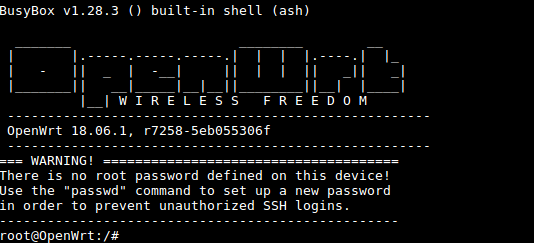
When your system boots for the first time it will automatically extend the TF card's file system to its max capacity:
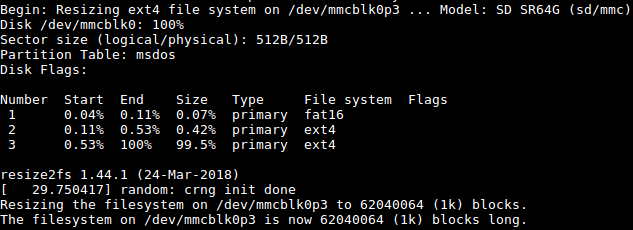
Please wait patiently for the process to be completed.
- Login via SSH
- Login via Web
OpenWrt supports system login and setup via the LuCI Web page.
By default the user is root without a password. You can click on the "Login" button to login.
1.3 Manage Software Packages
OpenWrt has a package management utility: opkg. You can get its details by running the following command:
$ opkg
Package Manipulation:
update Update list of available packages
upgrade <pkgs> Upgrade packages
install <pkgs> Install package(s)
configure <pkgs> Configure unpacked package(s)
remove <pkgs|regexp> Remove package(s)
flag <flag> <pkgs> Flag package(s)
<flag>=hold|noprune|user|ok|installed|unpacked (one per invocation)
Informational Commands:
list List available packages
list-installed List installed packages
list-upgradable List installed and upgradable packages
list-changed-conffiles List user modified configuration files
files <pkg> List files belonging to <pkg>
search <file|regexp> List package providing <file>
find <regexp> List packages whose name or description matches <regexp>
info [pkg|regexp] Display all info for <pkg>
status [pkg|regexp] Display all status for <pkg>
download <pkg> Download <pkg> to current directory
...These are just part of the manual. Here are some popular opkg commands.
- Update Package List
Before you install a package you'd better update the package list:
$ opkg update
- Check Available Packages
$ opkg list
At the time of writing there are 3241 packages available.
- Check Installed Packages:
$ opkg list-installed
At the time of writing 124 packages have been installed.
- Install/Delete Packages:
$ opkg install <pkgs> $ opkg remove <pkgs>
- Check Files Contained in Installed Packages:
$ opkg files <pkg>
- Install Chinese Language Package for LuCI
$ opkg install luci-i18n-base-zh-cn
- Check Changed Files:
$ opkg list-changed-conffiles
- Reference Links:
1.4 Check System Status
- Check CPU Temperature & Frequency
$ cpu_freq
Aavailable frequency(KHz):
480000 624000 816000 1008000
Current frequency(KHz):
CPU0 online=1 temp=26548C governor=ondemand freq=624000KHz
CPU1 online=1 temp=26548C governor=ondemand freq=624000KHz
CPU2 online=1 temp=26548C governor=ondemand freq=624000KHz
CPU3 online=1 temp=26548C governor=ondemand freq=624000KHzThese messages mean that there are four CPU cores working online simultaneously. Each core's temperature is 26.5 degrees in Celsius. Each core's frequency is adjusted on demand and the current working frequency is 624 MHz. You can reset the frequency by running the following command:
$ cpu_freq -s 1008000
Aavailable frequency(KHz):
480000 624000 816000 1008000
Current frequency(KHz):
CPU0 online=1 temp=36702C governor=userspace freq=1008000KHz
CPU1 online=1 temp=36702C governor=userspace freq=1008000KHz
CPU2 online=1 temp=36702C governor=userspace freq=1008000KHz
CPU3 online=1 temp=36702C governor=userspace freq=1008000KHzThese messages mean four CPU cores are working online. Each core's temperature is 26.5 degrees. Each core's governor is on demand and the frequency is 480 MHz.
- Check System Status on OpenWrt-LuCI Web
After you open the OpenWrt-LuCI page go to "Statistics ---> Graphs" and you will see various system statistics such as:
1) System Load:
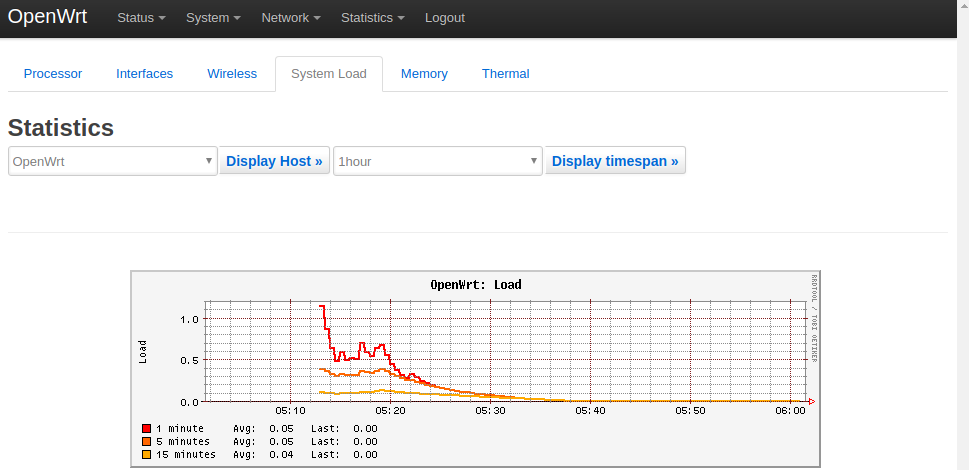
2) RAM:
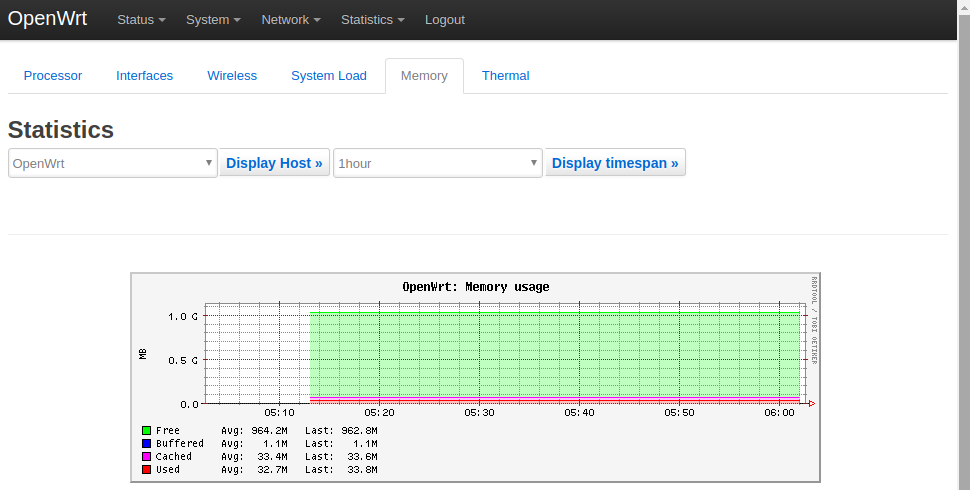
3) CPU Temperature:
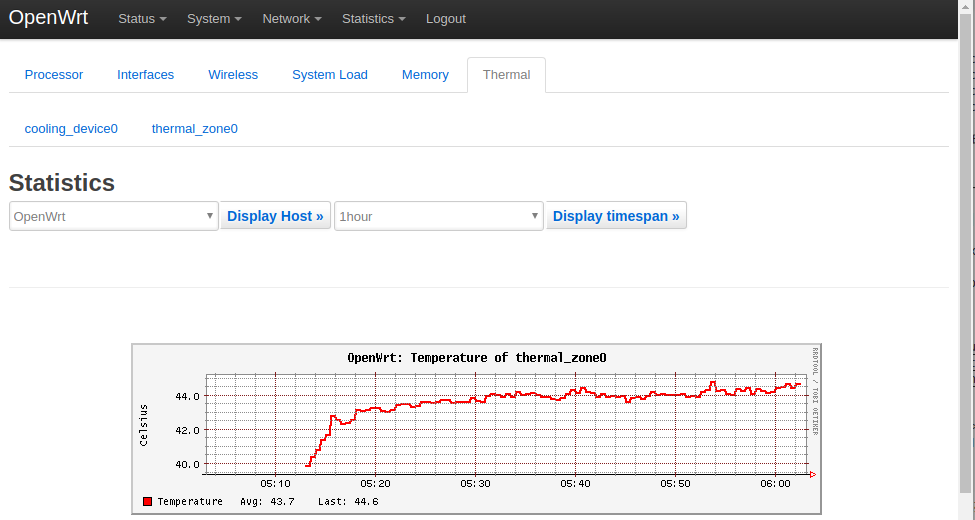
All the statistics listed on the Statistics page are provided by the luci-app-statistics package which uses the Collectd utility to collect data and present them with the RRDtool utility.
If you want to check more statistics you can install other collectd-mod-* packages.
All collectd-mod-* packages use the same configuration file: /etc/config/luci_statistics.
- Reference Links:
1.5 Check Network->Interfaces Configurations
- Open the OpenWrt-LuCI page, go to "Network ---> Interfaces" and you will see the network's configurations:
- All the configurations on the Network->Interfaces page are stored in the /etc/config/network file